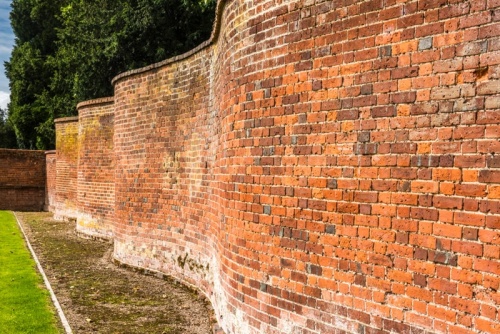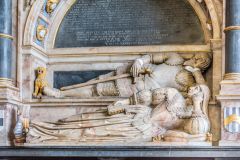
Wheathampsted is a pretty village in Hertfordshire, a few miles north of St Albans. The village is one of the most picturesque in the county, known for the large number of historic buildings in the village centre, clustered around the River Lea.
The name 'lea' may come from the Celtic word 'lugh', which translates loosely as 'bright'. In the 9th century, it formed part of the Danelaw boundary between territory controlled by Alfred the Great, to the south, and the Danes, to the north. It is now spanned by a bridge built in 1867.
History
The Wheathampstead area was inhabited in the late Iron Age, around 50 BC, by the Catuvellauni tribe, whose settlement acted as a tribal capital. The settlement was defended by earthwork banks and ditches, and by the River Lea itself.

Devil's Dyke
The best surviving remnant of the Iron age settlement is the Devil's Dyke, off Dyke Lane. The Dyke is about 400m long, with banks 40m across and up to 12m high. Devil's Dyke is claimed to be the site where Julius Caesar defeated the Catuvellauni and forced the British tribes to submit to Rome in 54 BC.
Long after the Romans left Britain there was a village grew up near the site of the former settlement. A timber church was built in the late Saxon period and was granted by Edward the Confessor to his new foundation of Westminster Abbey.
St Helen's Church
No trace of the original Saxon church remains. The present large St Helen's Church is primarily 13th and 14th-century work, with a restored 13th-century tower topped by a striking spire. Within the church is a beautifully carved 14th-century font given by the local Macry family, along with ornate tombs of the Brocket and Garrard families. Look for the statue of polar explorer Apsley Cherry-Garrard, who survived the ill-fated Scott expedition of 1911.
Tradition suggests that in 1312 the barons conspiring against Edward II and his favourite Piers Gaveston gathered their soldiers together at Wheathampstead. Messengers from the Pope tried to meet with them but the rebels refused the emissaries.

What to See
We've already mentioned the Devil's Dyke and St Helen's Church but there are so many more historic places to explore in the village. The local parish council publishes an excellent series of leaflets and maps, including one outlining the Wheathampstead Heritage Trail, linking 21 historic sites around the village. What follows is loosely based on the excellent Trail.
Bull Inn
The oldest inn in the village, the Old Bull is an attractive timber-framed building dating to the 16th century. The inn once formed part of Larmer manor estates. The Royalist commander General Monck is thought to have stayed here during the Civil War.
Tudor Archway
Walk along High Street, over the Victorian bridge over the River Lea, and you will see a 16th-century arch set in the brick wall in front of Wheathampstead Place. The brickwork at the top of the wall is Victorian but the lower courses are 16th century as is the arch itself.

Wheathampstead Place
The wall hides this attractive medieval hall house from view but if you carry on east along High Street to Mount Road you will get a good look at the house, sometimes called Place Farm. The hall house was built around 1480. It once had two cross-wings but only one remains. This may have been the site of the former rectory, but from 1500-1670 it was home to the wealthy Brocket family. In the early 19th century it was owned by Lord Melbourne, the first Prime Minister to serve under Queen Victoria. It was later owned by Lord Palmerston, another Prime Minister.
Railway Station
Go past Wheathampstead Place and follow Station Road to the end and you will find what remains of Wheathampstead Station. The station opened in 1860 as part of Great Northern Railway. The station closed in 1967 and the platform has now been restored. On the platform is a statue of playwright George Bernard Shaw, who lived at nearby Ayot St Lawrence and often cycled to the station.
Wheathampstead House
Opposite the station is Wheathampstead House, built in 1840 for Field Marshal the 10th Earl of Cavan. The house is screened from the road by a high wall added after the station was built to maintain the owners' privacy from railway passengers.

The Old Bakery & Mill
Returning along the west side of Station Road you come to the Old Bakery, a plastered 16th-century building with a 15th-century cross-wing and three 17th century gables facing the road. Beside the Old Bakery is Wheathampstead Mill. There has been a mill on this site for at least 1000 years, but the present building dates to the middle of the 16th century. The exterior weatherboarding was replaced with brick in 1890.
The original mill on this site was owned by Westminster Abbey, and records of the millers exist back to 1500. During the 17th century, Dissenters met at the mill. Among them was John Bunyan, author of Pilgrim's Progress. You can follow the mill race to its southern end where you will find a wellingtonia tree planted in 1815 to commemorate the Duke of Wellington's triumph at the Battle of Waterloo.
Crinkle-Crankle Walls
Just south of the mill you can turn into a lane leading west and you will find the former walled garden of the old rectory. The garden is enclosed by early 19th-century 'crinkle-crankle' brick walls, built in an undulating shape like a wave on its side. The unusual shape made it possible to build walls very high while still making them only 2 bricks wide. This method of construction also created natural alcoves useful for growing delicate fruit. The fruit was warmed by a stove that sent hot air through vents in the brickwork.
Further north from the walled garden is Bury Farm Cottages, the only part of Wheathampsteadbury Manor to survive. The complex of buildings was erected by Westminster Abbey in the 15th century as service buildings for the moated manor house.

On Church Street is Old Church School, built in 1862 on what was then the village green. The school's distinctive polychrome decorative brickwork is an excellent example of Victorian Decorated Gothic style, with bands of yellow brick and knapped flint.
Beyond the Old School (now used as offices) is the Grade II listed Brewhouse and Maltings, built in the late 18th century by James Wilkins. Behind their brick facades, the buildings have timber-frames. Look for the former cart entrance that led directly into a storage tunnel under the first cottage and then deep into the chalk hillside.
Swan Inn
Returning along High Street you come to the timber-framed Swan Inn, built in 1500 as an open hall house. The space between the timbers was originally filled with wattle and daub. The chimney is a relatively recent addition, added in 1680, and the elegant facade dates to 1750.
Continue north along the street and you reach Lattimores, built in the 16th century or perhaps even earlier. The brick facade was added in the 18th century but it hides a much older interior. The house is named for the Lattimore family, who owned the Hope Brewery and lived here until the late Victorian period.
The White Cottage
A near neighbour to Lattimores is the White Cottage, all that remains of a much larger 15th-century hall house. Again, the true age is hidden by the facade facing the street, but if you walk to one side of the building you can see the original 15th-century timbers.
On the corner of East Lane is The Two Brewers, built in the 17th century as a pub, but is now a shop.

Wicked Lady Pub
Just outside Wheathampstead at Nomansland is this old inn with an unusual name. The Wicked Lady is named for Lady Katherine Ferrers, a 17th-century highwaywoman active in the Wheathampstead area. Ferrers (1634-1660) was an orphan, married at 14 to her stepfather's nephew, who then took control of her fortune and used it to support the Royalist cause in the Civil War. According to legend, Lady Ferrers turned to a life of crime to counter her fast-disappearing fortune.
Tradition says that she was eventually shot while attempting a robbery on Nomansland Common in Wheathampstead, and died while trying to reach a secret staircase entry to her house at Markyate Cell. The tale has been embellished over time and probably confused with the career of 'Wicked' Lord Ferrers (no relation), the last member of the House of Lords to be hanged in England.
These are just a few of the historical highlights of Wheathampstead, one of the most picturesque villages in Hertfordshire and a place that repays a visit many times over.
There is free public parking on East Lane, signposted off the B651 (High Street) in the middle of the village.
About Wheathampstead
Address: B651,
Wheathampstead,
Hertfordshire,
England
Attraction Type: Village
Location: At the junction of the B651 and B653, five miles north of St Albans
Website: Wheathampstead
Location map
OS: TL178138
Photo Credit: David Ross and Britain Express
HERITAGE
 We've 'tagged' this attraction information to help you find related historic attractions and learn more about major time periods mentioned.
We've 'tagged' this attraction information to help you find related historic attractions and learn more about major time periods mentioned.
Find other attractions tagged with:
NEARBY HISTORIC ATTRACTIONS
Heritage Rated from 1- 5 (low to exceptional) on historic interest
Wheathampstead, St Helen's Church - 0.2 miles (Historic Church) ![]()
Devil's Dyke, Wheathampstead - 0.4 miles (Prehistoric Site) ![]()
Shaw's Corner - 2 miles (Historic Building) ![]()
Welwyn Roman Baths - 3.7 miles (Roman Site) ![]()
Codicote, St Giles Church - 3.9 miles (Historic Church) ![]()
St Albans, St Peter's Church - 4.2 miles (Historic Church) ![]()
St Albans South Signal Box and Railway Museum - 4.5 miles (Museum) ![]()
Mill Green Mill & Museum - 4.5 miles (Museum) ![]()
Nearest Holiday Cottages to Wheathampstead:
Biggleswade, Bedfordshire
Sleeps: 4
Stay from: £356 - 1504
Holmer Green, Buckinghamshire
Sleeps: 8
Stay from: £2188 - 7160
More self catering near Wheathampstead











